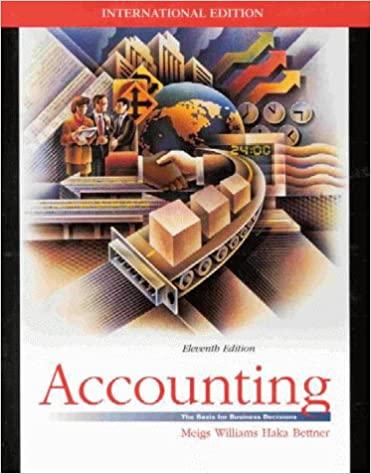On January 1, 2020, Purat Corporation acquired 75,000 shares of $10 par value common stock out of the 100,000-outstanding stock of Super Corporation. Purat common stock at January 1, 2020 was selling at $40 per share. Purat paid $120,000 cash for direct expenses and 100,000 for registration fees. Just prior the business combination, balance sheet information of the two corporations was as follows:
PuratSuperSuper
Book BookFair
Value ValueValue
Cash$500,000$120,000$150,000
Inventories800,000320,000400,000
Land2,100,000390,000200,000
Plant and equipment-net6,600,0002,500,0003,750,000
$10,000,000$3,330,000$4,500,000
Liabilities$2,300,000$500,000$300,000
Capital stock, $10 par value5,000,0001,000,000
Additional paid-in capital1,900,000430,000
Retained earnings800,0001,400,000
$10,000,000$3,330,000
Required:
1.Prepare the journal entry on Purat Corporation's books to account for the investment in Super Company.
2.Prepare a consolidated balance sheet for PuratCorporation and Subsidiary immediately after the business combination.
3. Record the transactions and compute the goodwill in case that Purat Co. purchased 40,000 shares of Super Co. Given that the Super reported net income of $500,000 and paid $200,000 dividends
On January 1, 2020, Purat Corporation acquired 75,000 shares of $10 par value common stock out of the 100,000- outstanding stock of Super Corporation. Purat common stock at January 1, 2020 was selling at $40 per share. Purat paid $120,000 cash for direct expenses and 100,000 for registration fees. Just prior the business combination, balance sheet information of the two corporations was as follows: Purat Super Super Book Book Fair Value Value Value Cash $500,000 $120,000 $150,000 Inventories 800,000 320,000 400,000 Land 2,100,000 390,000 200,000 Plant and equipment- net 6,600,000 2,500,000 3,750,000 $10,000,000 $3,330,000 $4,500,000 Liabilities $2,300,000 $500,000 $300,000 Capital stock, $10 par value 5,000,000 1,000,000 Additional paid-in capital 1,900,000 430,000 Retained earnings 800,000 1,400,000 $10,000,000 $3,330,000 Required: 1. Prepare the journal entry on Purat Corporation's books to account for the investment in Super Company. 2. Prepare a consolidated balance sheet for Purat Corporation and Subsidiary immediately after the business combination. 3. Record the transactions and compute the goodwill in case that Purat Co. purchased 40,000 shares of Super Co. Given that the Super reported net income of $500,000 and paid $200,000 dividends. On January 1, 2020, Purat Corporation acquired 75,000 shares of $10 par value common stock out of the 100,000- outstanding stock of Super Corporation. Purat common stock at January 1, 2020 was selling at $40 per share. Purat paid $120,000 cash for direct expenses and 100,000 for registration fees. Just prior the business combination, balance sheet information of the two corporations was as follows: Purat Super Super Book Book Fair Value Value Value Cash $500,000 $120,000 $150,000 Inventories 800,000 320,000 400,000 Land 2,100,000 390,000 200,000 Plant and equipment- net 6,600,000 2,500,000 3,750,000 $10,000,000 $3,330,000 $4,500,000 Liabilities $2,300,000 $500,000 $300,000 Capital stock, $10 par value 5,000,000 1,000,000 Additional paid-in capital 1,900,000 430,000 Retained earnings 800,000 1,400,000 $10,000,000 $3,330,000 Required: 1. Prepare the journal entry on Purat Corporation's books to account for the investment in Super Company. 2. Prepare a consolidated balance sheet for Purat Corporation and Subsidiary immediately after the business combination. 3. Record the transactions and compute the goodwill in case that Purat Co. purchased 40,000 shares of Super Co. Given that the Super reported net income of $500,000 and paid $200,000 dividends







